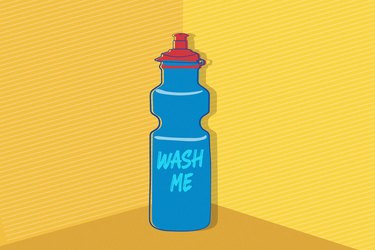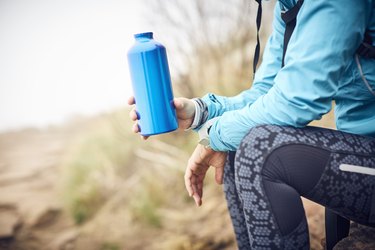
You might not think to clean your water bottle. If you're basically just filling it up with pure H2O and you're the only one drinking from it, it should pretty much always be germ-free — right?
Well, maybe not exactly.
Video of the Day
Video of the Day
Here's what happens if you don't clean your trusty gym or office water bottle, plus expert tips on how — and how often — you should give it a scrub.
What Happens if You Don't Clean Your Water Bottle
If you don't clean your bottle often enough, it can lead to a buildup of germs, which can then negatively affect your health. And when we say germs, we're talking mold and bacteria.
"Mold tends to grow in stagnant water, and since the bottle is never sterile, bacteria can grow, too," Maria Vila, DO, a family medicine specialist in Morristown, New Jersey, tells LIVESTRONG.com. "Also, if you are drinking directly from the bottle, bacteria from your mouth will be transferred to the water and grow inside your bottle."
In addition to your mouth, your bottle can pick up bacteria from your hands and any surface your water bottle touches. "Bacteria from your mouth is not so much of a concern because your body is familiar with it, but bacteria coming from your hands (and therefore from your larger environment) or coming from someone else whom you share a bottle with is the issue," says Alex Lewis, RD, LD, a dietitian for Baze.
Additionally, food particles from your mouth can transfer to your water bottle and create a hospitable environment for mold growth.
But Is That Bacteria and Mold All That Harmful?
Bacteria and mold grow in moist environments, and water bottles or any bottle of liquid you are drinking from can have mold, bacteria and possibly yeast, since it is not sterile, according to a 2014 paper in the Journal of Environmental Science and Health. Neglecting to clean (and dry!) your bottle between uses gives those little organisms room to thrive.
Plus, it's even worse if you put sweeteners or a sports drink into your water bottle. "If your drink has sugar, then this will accelerate the growth of organisms that can eventually make you ill if left out for a long time or if the bottle is not properly cleaned before the next use," Vila says. "Also, the pH of the liquid inside your bottle can affect the growth of organisms and potentially accelerate it."
If these organisms are being left behind because you're not washing your bottle, you can get sick. You may notice nausea and stomach upset, as well as fatigue, headaches or, if mold is present, allergy symptoms such as sneezing or nasal congestion, according to the Centers for Disease Control and Prevention (CDC).

Is It Ever OK to Skip Washing It?
You can get away with skipping a wash every now and then, but don't make it a habit.
"If you forgot to wash you water bottle and are in a situation where you may become dehydrated if you do not drink and reuse the dirty bottle, then it would be OK not to wash your bottle," Vila says. Just know that you are playing the odds of getting sick.
While drinking from a dirty reusable bottle is generally a no-no, it could be worse to reuse a single-use plastic bottle.
"Single-use plastic bottles are meant to be just that — only used one single time," Vila says. That's because the chemicals used in making the bottle can leach out into the water in subsequent uses and these chemicals, such as BPA, are known to be harmful to human health, Vila explains.
Plastic gets demonized more than other reusable bottles, but for good reason: "Versus stainless steel or glass, plastic can form small cracks that harbor bacteria more easily," says Kelly Jones, RD, LDN.
So ditch the single-use plastic after each use and grab a new one or, better yet, grab a reusable stainless steel or glass bottle.
Just don't fall for the common myth that stainless steel doesn't need to be cleaned. "Despite claims that steel can act as a natural antibacterial, research shows it actually has a very weak antibacterial capacity," Jones says.
How (and How Often) to Clean Your Water Bottle
Aim to clean your water bottle at least once a week — but every day or after each use wouldn't be a bad idea, either.
"Even as a dietitian with extensive food-safety training, I'm embarrassed to admit I only wash my stainless steel water bottle about once a week," Jones says. "Having said that, I do leave the top off for it to air dry daily, and only ever put water in it."
If someone is immunocompromised for any reason (this includes pregnant people), extra care should be taken to keep bottles clean, since these people are more likely to get sick from foodborne bacteria and molds. That might mean washing your bottle every day or after each use.
The best way to clean your bottle is with a bottle brush (like the OXO Good Grips Bottle Brush, $5.99 at Amazon.com) and some sort of cleaning solution.
"A bottle brush allows you to scrub all the way into the bottle to get it fully clean. Just make sure the brush you buy can fit into the water bottles you have and don't forget to clean the brush regularly," Lewis says.
Bottles can be washed using soap and water and then rinsing until the water runs clear. Or you can take it a step further for a deeper clean. "Soak it in a solution of half vinegar, half water overnight, then rinse and wash in the mornings," Vila suggests. "Vinegar is a known disinfectant and can help kill bacteria and mold growing in your bottle."
Consider a more intensive cleaning solution depending on the circumstance. "If you have a stainless bottle and let it sit in your car or gym bag for a few days in warm weather, consider soaking with baking soda and warm water before pouring boiling water in for a deep clean," Jones says.
Plus, keep your water bottle out of high-germ environments like the bathroom or your gym bag, adds Lewis, which can create more moisture.
And lastly, after washing, let it sit out to dry overnight. "Allowing your bottle to dry out after each use can certainly alleviate the risk of mold and bacteria growth, but most people don't remember to do that and may leave their water bottle with some liquid in it overnight, until their next workout," Jones says.
A bottle drying rack — such as the Marbrasse Retractable Cup Drying Rack ($9.99 from Amazon.com) — can help your bottles dry properly so they're not moist when you put them back in your cabinet or bag.

What to Look for in a Water Bottle
1. Large opening: Make sure your water bottle has an opening large enough for a brush to fit inside and that it is not too tall where a brush won't be able to reach the bottom. You want to be able to thoroughly clean it with the brush and have access to all of the parts, including the bottom and sides.
"Bacteria can form biofilms on the walls of your bottle, [and] you want to be able to disrupt these biofilms and remove them with a brush," Vila says.
Plus, a wide-mouth bottle will dry much more quickly than one with a small mouth.
2. Built-in straw: You might want to consider using a bottle with a straw built in.
"A small study [in Treadmill Reviews] that tested 12 water bottles found that a straw-top water bottle — where you drink water out of a straw that stays vertical the entire time — contained the least amount of bacteria," Lewis says.
3. Hands-free design: Avoid bottles where you have to use your hand to pop the lid (like a pop-up straw option), which makes it even easier for the germs on your hands to transfer to the mouthpiece of the bottle, Lewis adds.
So, How Bad Is It Really to Never Clean Your Water Bottle?
Let's face it: Many of us have taken a few sips from an unwashed bottle at some point and have been just fine. Initially, the symptoms of being exposed to bacteria and mold in the bottle may be subtle, and you might not even realize it's coming from the dirty bottle.
"Over time, however, these symptoms would worsen and you can become really ill, have daily persistent gastric symptoms or daily persistent allergy symptoms, [and] that is why it is recommended to wash your bottles," Vila says.
So, the takeaway? Spare a few minutes to wash your bottle! Once you're done with it for the day, give it a cleaning at night so it's fresh for the morning. Better safe than sorry, right?
Related Reading
- Journal of Environmental Science and Health: "Characteristics of Bacterial and Fungal Growth in Plastic Bottled Beverages Under a Consuming Condition Model"
- Centers for Disease Control and Prevention: "Basic Facts about Mold and Dampness"
- Treadmill Reviews: "A Look Under the Cap: Water Bottle Germs Revealed"
Is this an emergency? If you are experiencing serious medical symptoms, please see the National Library of Medicine’s list of signs you need emergency medical attention or call 911.
